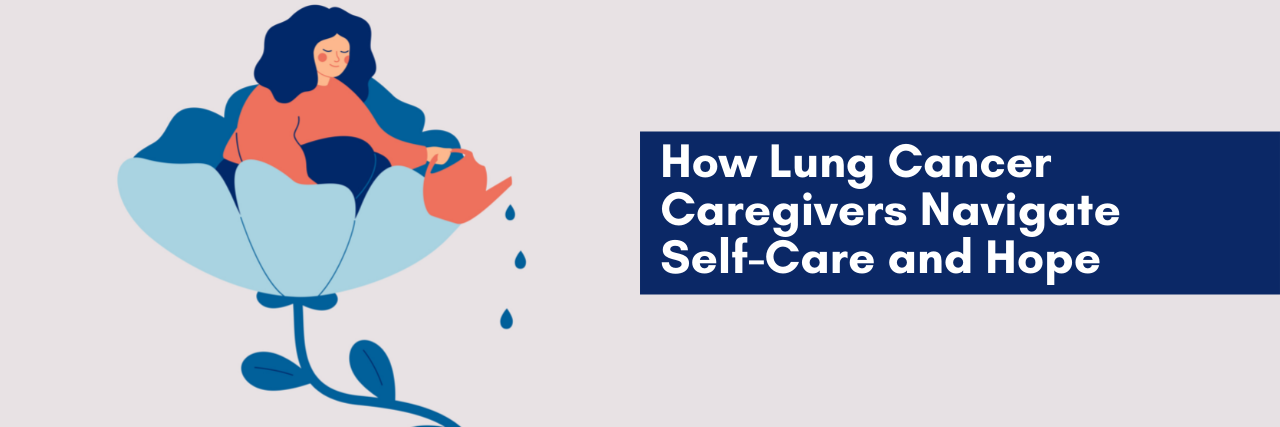An estimated 235,760 adults will get diagnosed with lung cancer this year, and behind many of these scary diagnoses, a wife, husband, child, parent, or friend is thrust into the role of caregiver.
• The Mighty’s Caregiving Toolkit
For Michelle Underwood, it was easier to see the line between “wife” and “caregiver” in the early stages of her husband’s non-small cell lung cancer diagnosis, but as his disease progressed, these lines became blurred. Her husband was 30 years old at the time of his diagnosis, which came only six months after the birth of their first child. Underwood took an active role in her husband’s care, accompanying him to every appointment, conducting follow-up research, tracking his medications, and sometimes being his voice in appointments when he was too tired to speak.
“I was his advocate, I was his wife, I was his caregiver,” she told The Mighty. “Towards the end, I was the decision-maker as well. So really, the patient-caregiver role for us was enmeshed in a way I never expected to experience. It was it was a very full-time role.”
While she had dealt with anxiety her whole life, she started having panic attacks during this time. One night while she was nursing her baby, she experienced intense itching that felt like it was coming from inside of her body. Later, she realized she was having a panic attack. In a 2016 survey from the National Cancer Institute, 42.2% of people caregiving for those with advanced-stage lung or colorectal cancers reported feeling elevated levels of anxiety, and 21.5% reported experiencing depression.
What “Self-Care” Means When You’re a Caregiver
Making time for “self-care” as a caregiver might seem like an oxymoron — when you’re not the one who’s sick, it’s easy to forget about your own care. But when it comes to caregiving, self-care isn’t just a buzzword — it gives you the fuel to keep going. Family caregivers spend an average of 24.4 hours per week providing care, and for those who reside with the caregiver, that number can go up to 45.
When Cindy Eastman‘s mother was diagnosed with lung cancer, she would go down to Florida to take care of her. Sometimes, her self-care strategy was to take breaks, even if it meant taking them five minutes at a time.
“I started allowing myself even five minutes to not make a phone call, not look something up, not return an email, just not do anything,” she said. “And that was hard. When you’re a caretaker, you feel like you have to be giving constantly. It’s hard to give yourself permission to take five and just not do anything.”
For Underwood, the support of family was key. Her youngest sister came to live with them, which she called a “saving grace.” Friends volunteered their time and made meals. Eventually her husband’s parents moved closer to help out. Continuing doing hobbies she loved also helped. She loved to read, so she read a lot. She continued exercising and even kept a blog. Although she didn’t have time to burn out completely, her panic attacks served as a somber reminder that she couldn’t continue taking care of her husband if she didn’t take care of herself.
“I knew that if I didn’t get my own mental health in order, there was no way I was going to be able to care for him, no way I was going to be able to care for our daughter,” she said. “So it is incredibly important to get yourself in a stable place so you can continue to care for the person who needs you.”
“The Hardest, Most Miserable. and Most Beautiful Thing”
While Underwood wouldn’t wish her caregiver journey on everyone, she does say there were sparks of good. The experience forced her to figure out what was important to her and deepened the relationship she had with her husband.
“We got to know each other on a very different level,” she said. “There had to be no shame. There had to be no fear. He trusted me literally with his life… Being a caregiver was the hardest, most miserable, and most beautiful thing I’ve ever had to do.”
She encourages other caregivers to be honest and direct about how they’re feeling. Seek out support from friends, family and community. Through a mutual friend, she was able to connect with a woman whose husband was also facing a cancer diagnosis. Supporting each other through this time — and even after their husbands’ deaths — was vital.
Eastman’s suggestion to caregivers is to not get lost in the role.
“Remember, you’re a person, you’re an individual, you have those needs and desires,” she said, “They may not get met every single time, but you do have them and they are important. I’m a mother, a wife, a writer, a daughter, and a caregiver, but I’m also still Cindy.”
And hope? Well, that’s a hard one, but both woman agree it’s hard to navigate a lung cancer journey without at least a little of it.
“Hope is everything,” Underwood said. “That’s just part of life. We hope for things every day. We always knew he was going to die one one day from cancer, but we always had hope that we could stretch it out a little longer. And that got us from one point to the next. That hope that he was going to make it to see our daughter go to kindergarten. You start with those little goals, and that’s what gets you to the next place.”
If you’re a caregiver, what does hope mean to you? Let us know in the comments below.

